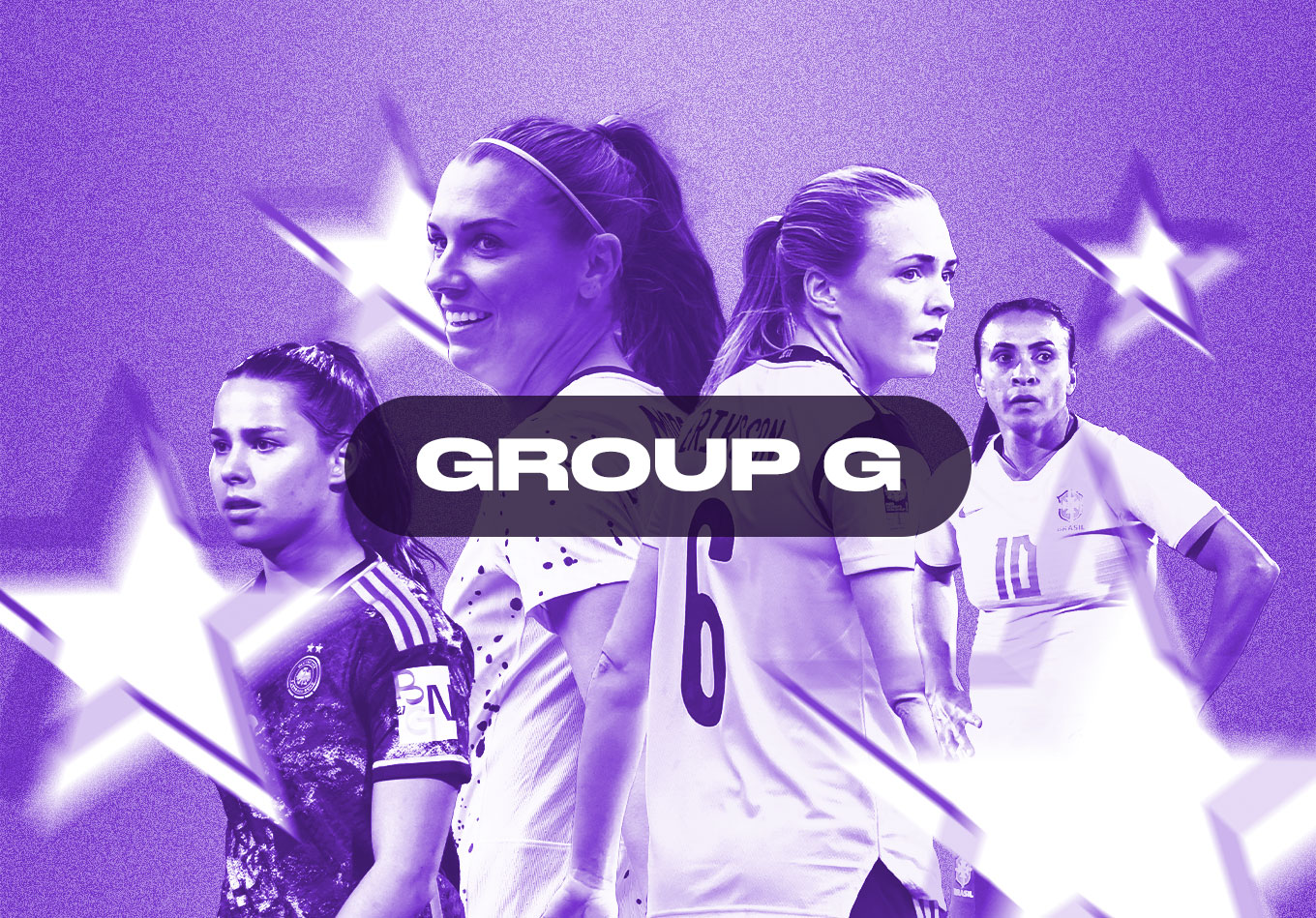Often the bridesmaids, never the brides, Sweden are back to try and finally win their first FIFA Women’s World Cup, while also trying to get the best out of their star player on the international stage.
Italy return for another crack, hoping to do significantly better than they did at last summer’s UEFA European Women’s Championship, while Argentina and South Africa will both be looking to put a spanner in the works for their European opponents.
Here’s our Group G preview.
Sweden
Aiming to Finally Win
The Swedish women’s top-flight, Damallsvenskan, has dropped to sixth place in the UEFA rankings. After many years of being at the top of that list, Swedish women’s football is trying to figure out how to move forward in a world where the game is snowballing.
However, the Swedish women’s national team still ranks third in the world on FIFA’s list. When the ninth edition of the FIFA Women’s World Cup kicks off on 20 July, 32 years after the inaugural tournament was played in China (1991), Sweden will be one of seven to have played in every single edition, along with the United States, Germany, Norway, Brazil, Japan and Nigeria.
The only time Sweden have not made it further than the group stage was in 2007. On all other occasions, the Swedes have participated in the knockout stage, competing for glory.
No team has played as many games as Sweden in the Women’s World Cup without ever winning the tournament, which is a record they’ll be keen to end with victory in Australia and New Zealand. They have played 40 matches in the tournament’s history and reached the semi-finals in four of the previous eight editions, making it to the final only once in 2003, when they lost 2-1 against Germany.
Can Blue and Yellow Dreams Become Reality?
In an interview with SVT Sport ahead of the World Cup, Sweden and AC Milan’s Kosovare Asllani said: “We are not the only favourites, but you should never count Sweden out. That’s the dream we’re chasing; we want to win that gold medal – nothing else.”
The creative midfielder has a point. Sweden have so far always levelled up their game in big, international tournaments, even though they received a lot of criticism during last summer’s UEFA Women’s Euros, which they were knocked out of by hosts England in the semi-finals after entering the tournament as one of the favourites to win it. The squad selected to represent the colours of blue and yellow in this edition of the Women’s World Cup know the drill. They know what it will take to go all the way. But do they have what it takes?
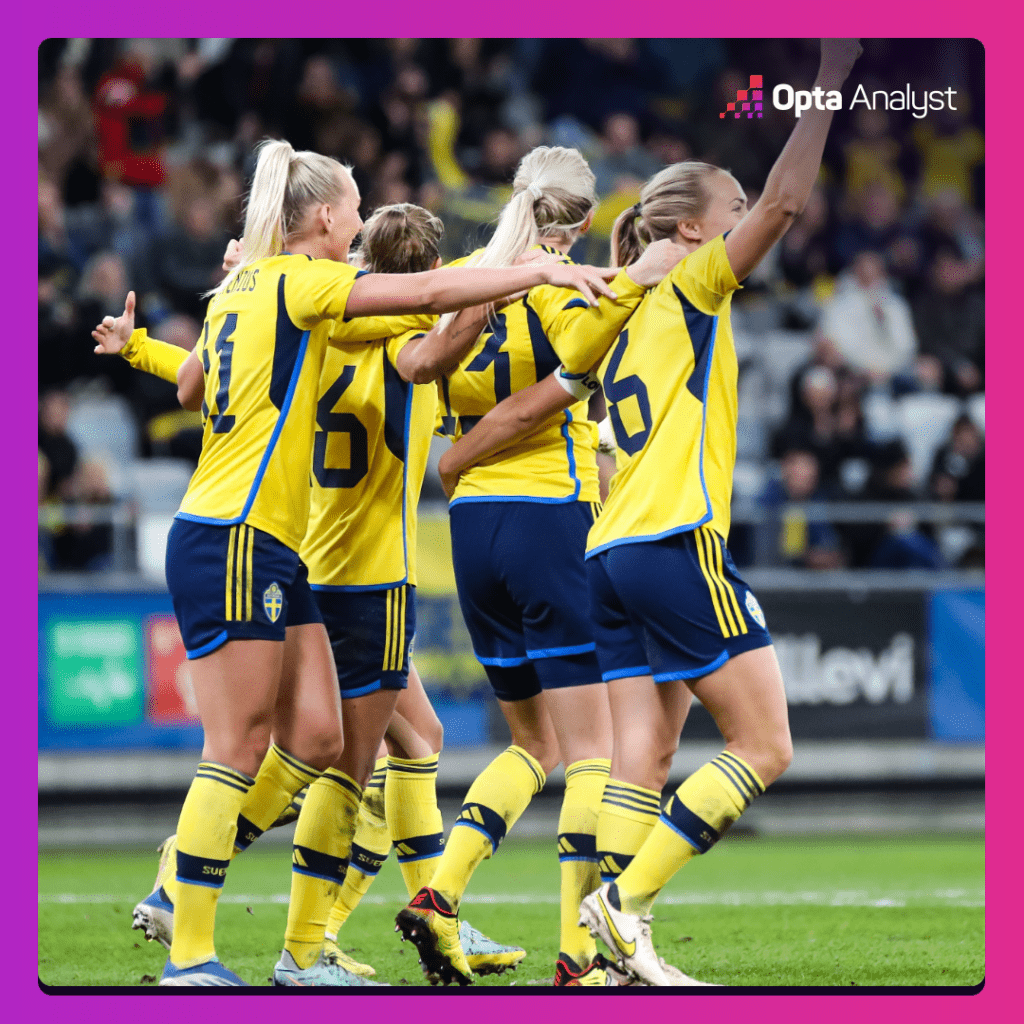
USA – Again?
No two teams have faced each other more often at the Women’s World Cup than USA and Sweden, who have met in six of the previous eight tournaments, with all meetings coming in the group stage. This will be the first tournament since 1999 that the two are in separate groups, but their respective roads to the final can cross in the semi-finals if they both win their groups and go on to reach the final four.
And speaking of the USA, Sweden have been on the Women’s World Cup podium four times, the second-best total for a team, only behind the USA, who have done so eight times. As already mentioned, Sweden have never won the World Cup but finished as runners-up in 2003 and have won the bronze medal on three occasions (1991, 2011 and 2019).
Sweden will probably be happy to have avoided the USA this time since they have lost only three of their 15 group stage games played in the competition in the 21st century, with all three defeats coming against the USWNT.
The Fridolina Rolfö Debate
After Sweden’s performance at last summer’s Euros, there was endless discussion and criticism towards Sweden’s Diamantbollen winner in 2021 and 2022 – Fridolina Rolfö.
People expect the Barcelona star to perform magic whenever she steps out on the pitch wearing the blue and yellow shirt because of the club she plays for. At Barca, Rolfö is an attacking left-back with the role of creating chances from the flank.
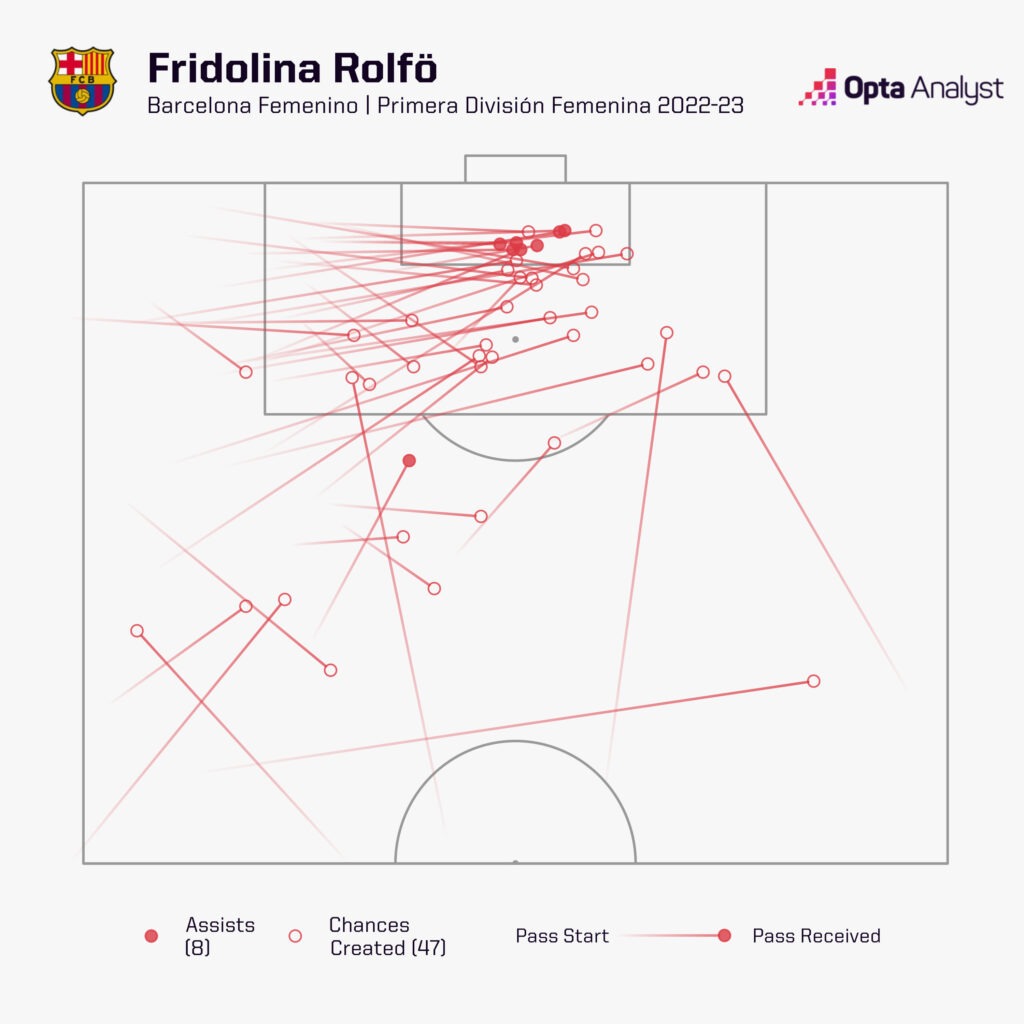
The focus should be on what a player like Rolfö can add for her team, whether at club or international level, when she is given a role that allows her creative abilities to shine. The tall and strong Swede with excellent progressive passing had an impressive record of eight assists and 47 chances created for Barcelona last season.
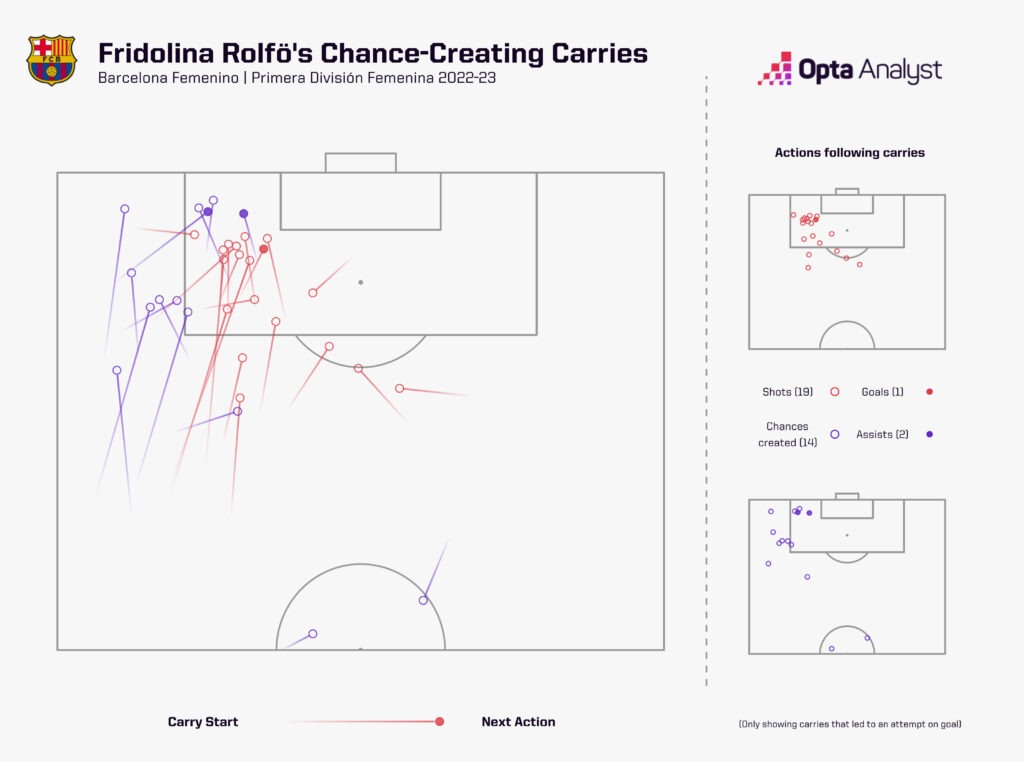
Her progressive ball-carrying led to 19 shots, one goal, two assists and 14 chances created. These abilities give the Swedish head coach a hard time when deciding where a player like Rolfö could add the most value to an already very talented team. Rolfö has played in the number 10 position, but that often leads to her receiving the ball with her back to goal, and if there’s one weakness in her game, maybe that is it.
What she does week in and week out with Barcelona is perhaps something she struggles to apply to Sweden as the style of play differs massively, as do the abilities of the players around her. The idea that Rolfö will come out on the pitch wearing the Swedish match shirt and do everything should be dismissed immediately – not because she isn’t a world-class player, but because Sweden’s style of play is built on teamwork rather than one individual.
“Our first attacker is our first defender,” said Sweden manager Peter Gerhardsson when talking about the role of central striker Stina Blackstenius, which points to the fact that Sweden defend as a team and attack as a team. With this mantra, they try to avoid too many 1v1 situations out of possession, which they will have to work on to improve.
It will affect the rest of the team if Blackstenius doesn’t defend well out of possession, meaning that the Arsenal forward and Rolfö will both need to perform at the highest level, but they are not alone in the burden to make it happen for Sweden, no matter what people might think.
Defensive Doubts
There have been concerns raised about Sweden’s defence in the last year, which had been a notable strength for the last decade. Many Swedish reporters and pundits have discussed the experienced key players’ lack of playing time in the Swedish backline.
But is it true? Magdalena Eriksson (formerly of Chelsea, now at Bayern Munich) was one of five players in Emma Hayes’ side who played the most games last season across all competitions, along with Sam Kerr, Guro Reiten, Erin Cuthbert and Niamh Charles, making 36 appearances overall.
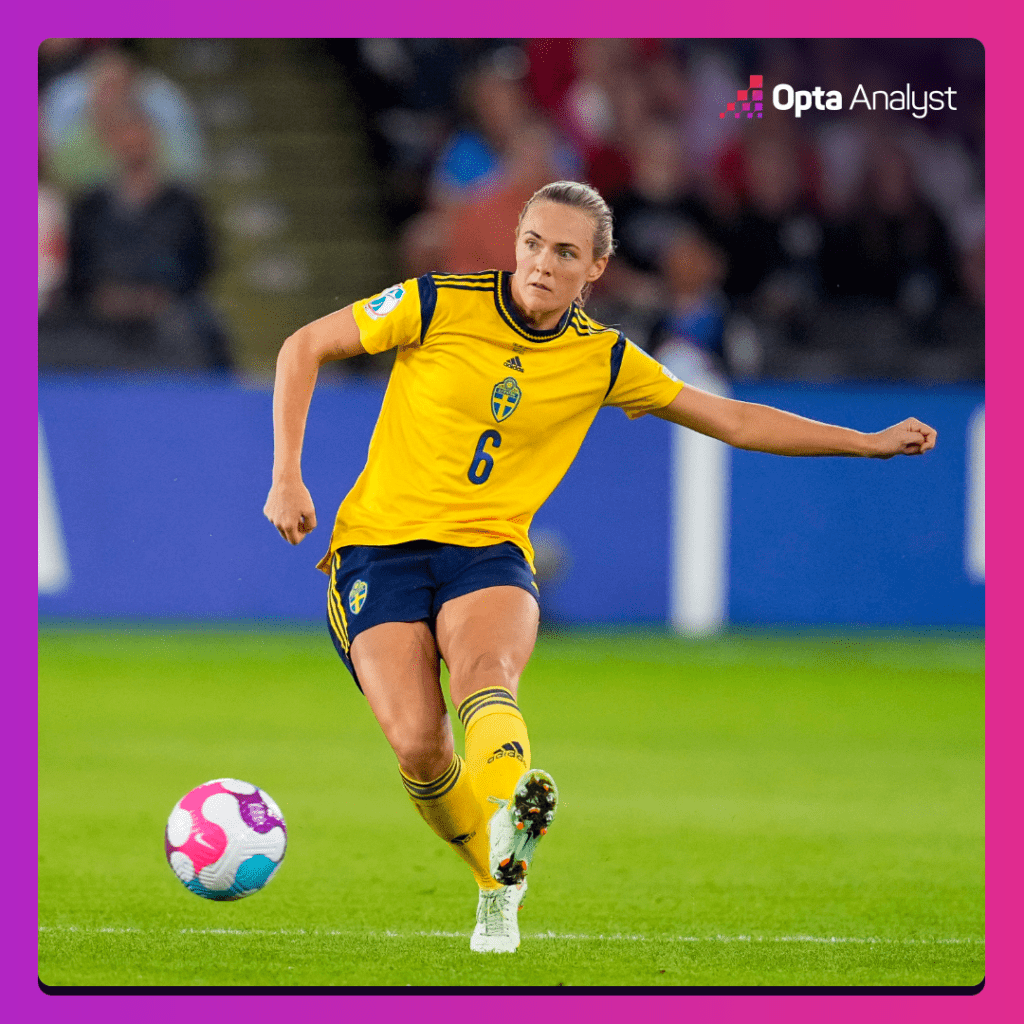
In the qualifiers, she was one of five Swedish players with the most appearances as the only defender, accompanied by Rolfö, Lina Hurtig (Arsenal), Filippa Angeldahl (Manchester City) and Olivia Schough (FC Rosengård). That Gerhardsson continues to show plenty of faith in the former Chelsea skipper is in no doubt.
Another worry has been the prolonged absence of Caroline Seger (FC Rosengård), who comes into this tournament with only 101 minutes of playing time with her club team from last season. Sweden’s captain is the outfield player to have started the most games at a Women’s World Cup without scoring a goal (17). However, she has so often been a vital part of the Swedish defensive unit, making 18 interceptions during the 2019 tournament, a joint-high among all players along with England’s Lucy Bronze and the Netherlands’ Desiree van Lunteren.
How much of an impact will it have on Scandinavia’s best-ranked national team to not have their captain fit and ready to play a full 90 minutes when it all starts? Seger has been the glue to link play for Sweden, with Gerhardsson alternating between a back three and a back four in his efforts to implement more of a ball-playing style when in possession. Still, you will see Sweden seek to attack as fast as possible when winning the ball in areas where they can utilise their counter-attacking strengths, and it is probably in this way they can hurt opponents most.
However, looking at what is about to come, Sweden have lost four Women’s World Cup games despite scoring the opening goal, more than any other team in the competition’s history. On a more positive note, they can be optimistic ahead of their opener against South Africa on July 23, as Sweden are unbeaten in the opening game of their last four WWCs, having lost their first four such games.
Italy
In-form Azzurre
The Italians will appear in their fourth Women’s World Cup as they have managed to qualify for back-to-back tournaments for the first time. They reached the quarter-finals in two of their past three appearances in the competition.
They will travel to New Zealand and Australia after finishing top of their qualifying group, winning nine and losing only one of their 10 games, keeping nine clean sheets.
Italy start their campaign against Argentina on 24 July, and it bodes well that they are unbeaten in their opening games at the Women’s World Cup (W2 D1). However, they have also always lost exactly one match in each of their previous three group stages in the tournament.
The Roma Effect
Roma have just had a historic season in which they won the club’s first Serie A league title while also playing in the UEFA Women’s Champions League. Six players from Roma can be found in the top 10 for attacking sequence involvements from the 2022-2023 season, and four of those are Italians selected by head coach Milena Bertolini to play in the World Cup: Manuela Giugliani, Valentina Giavinti, Giada Greggi and Annamaria Serturini.
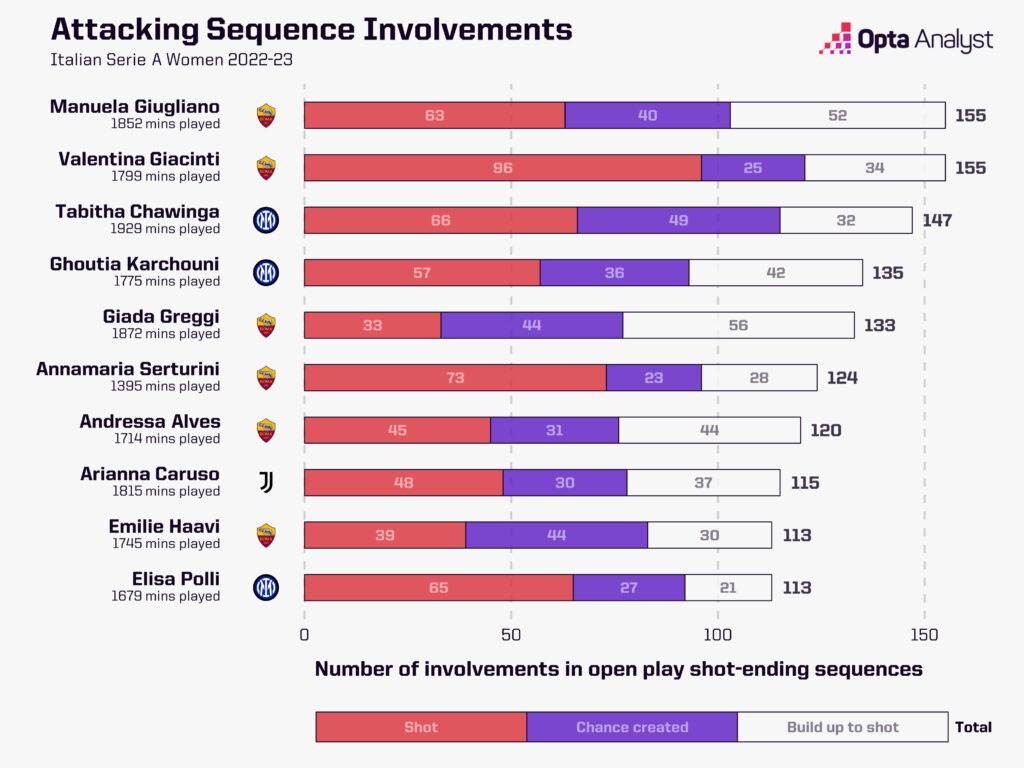
Yet, the player with the most goals and appearances for Italy in qualifying was Cristina Girelli (Juventus), who played 10 games and scored eight times. It will be curious to see if Bertolini uses the Roma players to attack, or will she go with her more tried and tested pairing of Girelli and her club teammate Barbara Bonansea?
A Head Coach Under Pressure
When Italy did not even make it past the group stage at last summer’s Euros, many probably raised an eyebrow. Mainly because they failed to score, but also because they conceded seven goals. With that in mind, when it comes to Italy’s performances in the last World Cup in France 2019, only China (84%) had a better save percentage than Italy (83%), who were also one of the two teams, alongside Norway (23), to make 20+ saves in the last edition (20).
Most of the time, Italian football is played from the heart, but they did not make it happen last summer.
Bertolini has hopefully prepared her players better for this challenge because if they are unable to make it to the knockout stages down under, it could get ugly for the head coach in charge of a nation that has seen women’s football take giant steps forward in recent years.
Argentina
Can the Women Emulate Messi and Co?
Argentina will participate in their fourth Women’s World Cup, though they have never been past the group stage, failing to do so in 2003, 2007 and 2019. There will be a belief that nothing is impossible following the men’s success – led by Lionel Messi – in Qatar last year. No country has ever held the World Cup titles for both men and women simultaneously.
They are here to play in the 2023 edition of the World Cup after qualifying via the 2022 Copa América Femenina, where they finished in third place.
Effectiveness Can Shatter Dreams
Argentina have failed to score in 67% of their Women’s World Cup games (six out of nine), the highest percentage among the teams to have played more than six games.
Although, in 2019 they lost just once after losing each of their previous six matches in the history of the competition, and were the only team that managed to avoid defeat in a game that saw them trail by three or more goals, coming back from 3-0 down to draw 3-3 with Scotland.
What may be the biggest concern for Argentina is that they have conceded on average 4.1 goals per match at the Women’s World Cup (37 goals in nine games), the highest ratio among teams to have taken part in at least three tournaments.
Key Players
Yamila Rodríguez (Palmeiras) was Argentina’s top scorer in the 2022 Copa América Femenina. She scored six goals from an expected goals value of just 3.0 during that tournament, with her +3.0 margin the biggest of all players.
Some experts in the country have also mentioned the double pivot in the midfield; Daiana Falfán (Palmeiras) and Lorena Benítez (UAI Urquiza) will likely be key.
It could get exciting for Argentina in the first match when they play Italy, who some will see as beatable. If they manage to defeat them, it will put the Azzurre under tremendous pressure and could see Group G become very interesting early on.
South Africa
Second Chances
South Africa will participate in their second Women’s World Cup after debuting in 2019, when they lost all three games.
They qualified for the 2023 edition by winning the 2022 Women’s Africa Cup of Nations, their first title ever.
In that competition, they scored more goals than any other nation with 10. South Africa also made the most successful passes per game in that competition, 335.
Money Problems
As many other teams have, South Africa demanded better support from their federation. This led to a boycott from the players, who refused to play in the team’s warm-up match against Botswana ahead of the World Cup.
The reasons for the players refusing to play were many. One was that the pitch the match was supposed to be played on was in bad condition and they did not want to risk injury.
Another reason was the financial agreement with the South African Football Federation before the tournament. According to the players, they receive historically hefty monetary compensation from FIFA but nothing from their federation.
The result of the match? South Africa lost 5-0 to Botswana as the management had to use other players, with the youngest of them just 13 years old.
However, they resolved the financial conflict soon after, seeing the players receive about £9,000 each, in addition to the £23,000 FIFA previously promised to all participating players.
Finding a Route to Goal
During their only appearance in the competition back in 2019, South Africa had just four shots on target. That was a joint-low that year alongside New Zealand, scoring one goal in their opening game against Spain (a 3-1 defeat). They also had only 17 touches in the opposition box, the fewest for a team during the tournament.
They hope to make more of an impact this time, maybe with the help of Thembi Kgatiana of NWSL side Racing Louisville, who scored that goal against Spain in 2019. On top of that, Kgatiana was responsible for three of South Africa’s four shots in the tournament in France, but scored from her only shot on target, fired from outside the box.
South Africa’s tournament starts against Sweden on 23 July.
Enjoy this? Subscribe to our mailing list to receive exclusive weekly content. And follow us on Twitter too.
